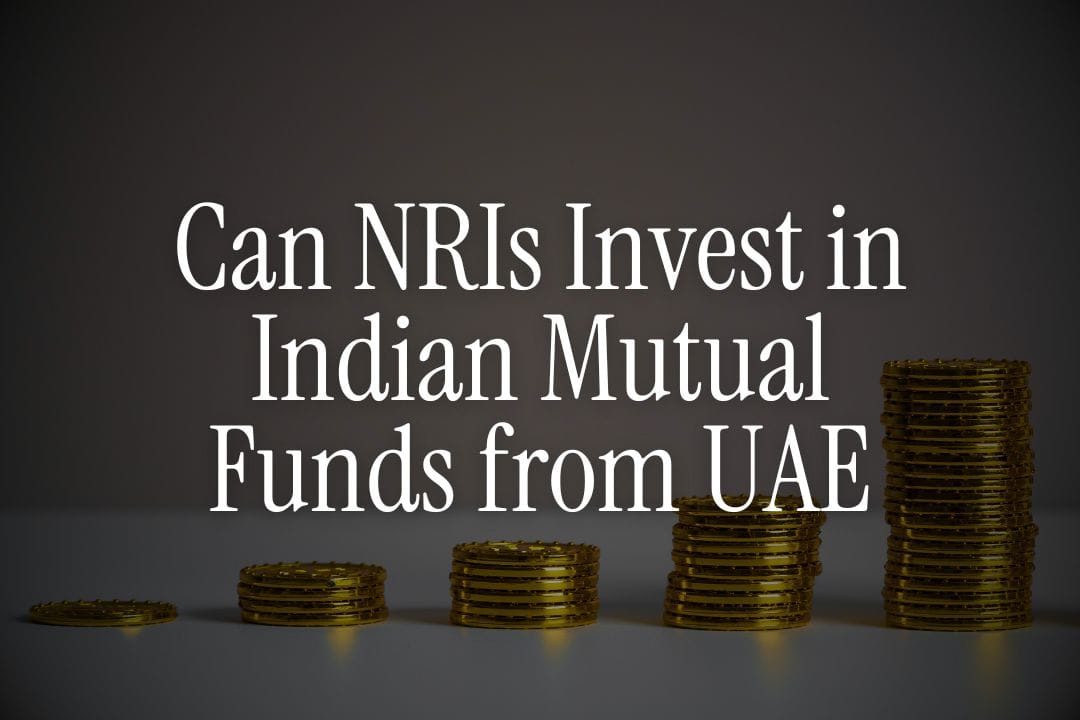
You're sitting in your Dubai apartment, scrolling through investment options. Your colleague just told you he's earning 14% from Indian mutual funds.
You're intrigued, but immediately three questions pop up: Is this even legal?
How much can I invest? And most importantly-can I get my money back to the UAE when I need it?
At Belong, we work with thousands of NRIs across the UAE-Dubai, Abu Dhabi, Sharjah-who've asked us these exact questions. Our WhatsApp community of 5,000+ members discusses these concerns daily.
The short answer: yes, you absolutely can invest in Indian mutual funds from the UAE. The slightly longer answer: there are rules, limits, documentation requirements, and smart ways to do it that protect your capital and minimize tax.
This guide walks you through everything-RBI regulations, FEMA limits, repatriation rules, platform options, KYC from abroad, taxation under India-UAE DTAA, and how to set up your first SIP without flying to India.
By the end, you'll know exactly what's allowed, what's not, and how to get started this week.
Yes, NRIs Can Legally Invest in Indian Mutual Funds from UAE
Let's clear this up front: investing in Indian mutual funds as an NRI living in the UAE is 100% legal and regulated by the Reserve Bank of India (RBI) under FEMA (Foreign Exchange Management Act).
You don't need special permission. You don't need to be in India. You don't need an Indian address. What you need is:
- Valid NRI status (you've been outside India for more than 182 days in a financial year)
- PAN card (Permanent Account Number for tax purposes)
- Indian bank account (NRE or NRO account)
- Completed KYC (Know Your Customer verification)
That's it. The process is fully digital now. Most banks and mutual fund platforms support video KYC, which means you can complete everything from your Dubai office or home.
NRI investments in Indian mutual funds have grown 23% year-on-year as of September 2024, with UAE-based investors forming the largest NRI cohort.
Why the surge? Three reasons:
- Rupee-linked returns: Indian equity markets have delivered 12–14% CAGR over 15-year periods.
- Diversification: You're earning in AED, spending in AED, but your wealth grows in INR-spreading currency risk.
- Repatriation clarity: With proper account setup, your money is fully movable back to the UAE.
👉 Tip: Before you invest, confirm your residential status using our NRI Status Calculator. Your tax treatment depends on this.
Understanding FEMA Rules: What NRIs Are Allowed to Invest In
The Foreign Exchange Management Act (FEMA) governs all NRI investments in India. Here's what you need to know.
What NRIs Can Invest In
Under the Portfolio Investment Scheme (PIS) and general FEMA provisions, NRIs can invest in:
- Mutual funds (equity, debt, hybrid-all categories)
- Direct stocks (through PIS route, up to 5% of a company's paid-up capital)
- Fixed deposits (NRE, NRO, FCNR deposits)
- Government securities and bonds
- Real estate (with restrictions-can buy residential/commercial, but not agricultural land)
- National Pension System (NPS)
- Insurance policies (term, endowment, ULIPs)
Also Read -Term Insurance for NRI
For mutual funds specifically, there are no investment limits on the amount you can invest. Unlike stocks (where there's a 5% individual cap per company), mutual funds are unrestricted.
Also Read -Pravasi Pension Scheme for NRIs & Residents
What NRIs Cannot Invest In
- Agricultural land, plantation property, or farmhouses (prohibited under FEMA)
- Small savings schemes like PPF, Kisan Vikas Patra, NSC (these are for residents only)
- Certain government savings certificates
Also Read - Which bank is best for fixed deposit in india
Repatriation Rules Under FEMA
This is the part most NRIs care about: can you bring your money back to the UAE?
If you invest through an NRE account:
- Both principal and gains are fully repatriable with no limits.
- No RBI approval needed.
- No annual caps.
If you invest through an NRO account:
- Repatriation is capped at $1 million per financial year (April–March).
- Requires Form 15CA and 15CB (CA certificate) for large amounts.
- Used primarily for income earned in India (rent, dividends, interest).
Also Read -How to Repatriate Funds from NRO/NRE Accounts
We'll cover NRE vs NRO in depth shortly, but here's the golden rule: if you're investing with money earned abroad (your UAE salary), use an NRE account. It keeps everything clean, repatriable, and tax-efficient.
Read more: NRE vs NRO vs FCNR: Which Account Should You Use?
Is There a Maximum Amount for Mutual Fund Investment?
No. Unlike the Liberalized Remittance Scheme that applies to residents (₹2.5 lakh annual cap on foreign investments for residents), NRIs have no upper limit on how much they can invest in Indian mutual funds.
You could invest ₹10 lakh, ₹1 crore, or ₹10 crore-as long as:
- The money comes from legitimate sources (salary, savings, sale of assets).
- You've completed KYC and have proper documentation.
- You're investing through NRE/NRO accounts in your own name.
NRE Account vs NRO Account: Which One Should You Use for Mutual Funds?
This decision is critical. It affects your tax treatment, repatriation ease, and compliance burden.
NRE Account (Non-Resident External Account)
What it is: A rupee-denominated account funded by foreign currency (your AED salary converted to INR).
Key features:
- Fully repatriable (principal + interest + gains)
- Interest earned is tax-free in India
- Joint holding allowed (only with another NRI)
- Cannot be funded by rupee income earned in India
Best for: Mutual fund investments that you plan to repatriate back to the UAE eventually.
Taxation: Interest is exempt. Mutual fund capital gains are taxed normally (12.5% LTCG on equity, slab rate on debt), but TDS is deducted at the time of redemption.
NRO Account (Non-Resident Ordinary Account)
What it is: A rupee account that can hold both foreign income and India-sourced income (rent, dividends, pension).
Key features:
- Repatriation limited to $1 million per financial year
- Interest is taxable at 30% (with TDS)
- Can be jointly held with residents
- Used for managing Indian income
Best for: Holding rental income, pension, or other India-sourced funds. Not ideal for mutual fund investments you plan to repatriate.
Taxation: Interest taxed at 30%. Mutual fund gains taxed normally, but repatriation requires Form 15CA/15CB.
Side-by-Side Comparison
Feature | NRE Account | NRO Account |
|---|---|---|
Funded by | Foreign income (salary abroad) | Indian income (rent, pension) or foreign income |
Repatriation | Fully repatriable (no limit) | Up to $1 million/year |
Interest taxation | Tax-free | 30% TDS |
Best for mutual funds? | Yes | Only if you don't plan to repatriate |
Paperwork for repatriation | Minimal | Form 15CA/15CB required |
Also Read - NRE vs NRO Account for Mutual Fund Investments
Our Recommendation at Belong
Always use an NRE account for mutual fund investments unless you're investing India-earned income (like rent from a property in Mumbai) that's sitting in your NRO account.
Why?
- Full repatriation with zero hassle.
- No $1 million annual cap.
- Cleaner documentation.
- No need for CA certificates.
Learn how to open one: Best NRE Accounts for NRIs.
Compare leading banks: Best Banks for NRI Accounts.
Step-by-Step: How to Invest in Indian Mutual Funds from UAE
Let's walk through the actual process. This is what you'll do over the next 7–10 days.
Step 1: Open an NRE or NRO Account
You need an Indian bank account. Most major banks now allow full online account opening for UAE residents.
Recommended banks:
- ICICI Bank: Strong digital platform, video KYC, dedicated NRI relationship managers. Learn more.
- HDFC Bank: Fast turnaround, extensive UAE branch network. Guide here.
- Axis Bank: Competitive rates, smooth SIP mandate setup. Details.
- SBI: Largest network, slower processes but reliable. Guide.
Documents required:
- Passport (with UAE visa)
- Emirates ID
- UAE residence proof (DEWA bill, tenancy contract, Emirates ID)
- PAN card
- Recent photograph
- Cancelled cheque (if linking an existing account)
Timeline: 3–7 days for account approval.
Compare rates and features: NRI Fixed Deposit Rates.
Step 2: Apply for a PAN Card (If You Don't Have One)
PAN (Permanent Account Number) is mandatory for all financial transactions in India. You cannot invest in mutual funds without it.
How to apply from UAE:
- Visit NSDL TIN portal.
- Fill Form 49A (for NRIs).
- Upload passport copy, UAE address proof, and photograph.
- Pay ₹1,020 (approx. AED 45).
- Submit documents to the Indian Embassy in UAE or courier to NSDL India.
Timeline: 15–30 days.
Also Read -How to Link Aadhaar and PAN to Your NRI Bank Account
👉 Tip: If your PAN still shows an old Indian address, update it online using the Income Tax portal before you start investing. Address mismatches can cause KYC failures.
Step 3: Complete Mutual Fund KYC
Once your bank account and PAN are ready, you need to complete KYC with a SEBI-registered KRA (KYC Registration Agency).
Option 1: In-person verification during India visit - If you're visiting India, walk into any bank branch or AMC office with your documents.
Option 2: Through your bank - Some NRI-friendly banks (ICICI, HDFC, Axis) complete mutual fund KYC as part of account opening.
Documents for KYC:
- PAN card
- Passport
- UAE visa
- UAE address proof (utility bill, Emirates ID)
- Cancelled cheque from NRE/NRO account
- Recent photograph
Timeline: 1–2 days
Learn more: How to Start a SIP as an NRI.
Step 4: Choose a Platform or Invest Directly
You have two routes:
Route 1: Direct with Asset Management Companies (AMCs)
Invest directly through fund houses like HDFC AMC, ICICI Prudential, SBI Mutual Fund. You'll need separate logins for each fund house.
Pros: No intermediary, full control.
Cons: Multiple logins, no unified dashboard.
Route 2: Online Investment Platforms (Aggregators)
Platforms like Kuvera, Groww, INDmoney, Zerodha Coin, and ET Money let you invest in all funds from one dashboard.
Pros: Single login, unified portfolio view, goal-based planning tools.
Cons: Some platforms charge fees or push regular plans (higher expense ratio).
Which Platforms Work for NRIs?
Based on our testing and community feedback:
- Kuvera: NRI-friendly, supports NRE/NRO accounts, clean UI, direct plans only.
- Groww: Works for NRIs, video KYC available, occasional address verification glitches.
- INDmoney: Supports NRIs, offers tax filing assistance.
- Zerodha Coin: Direct plans, but requires a Zerodha trading account (demat).
👉 Tip: Always verify the platform supports NRI accounts and accepts international KYC documents before uploading everything.
Step 5: Link Your NRE/NRO Account and Set Up SIP
Once KYC is done:
- Add your NRE or NRO bank account on the platform.
- Upload a cancelled cheque for verification.
- Set up auto-debit mandate (NACH) for SIPs.
- Choose your funds (we'll cover selection criteria shortly).
- Start your first SIP-minimum ₹500 to ₹5,000 depending on the fund.
Timeline: SIP starts on your chosen date (1st, 5th, 10th, 15th of the month).
Read our selection guide: How to Choose the Right Mutual Fund as an NRI.
Step 6: Transfer Money from UAE to India
Your SIP is set up, but your Indian account needs funds. Here's how to send AED to INR.
Transfer options:
Bank SWIFT transfer: Most UAE banks support this. Takes 1–3 days, fees AED 50–100, exchange rates 1–2% worse than market.
Online platforms (Wise, Remitly, Vance): Better rates (0.3–0.5% markup), lower fees (AED 15–25), faster delivery. Recommended.
Exchange houses (UAE Exchange, Al Ansari): Good for cash transfers but not suitable for NRE account credits.
RBI requirements:
- Mention purpose code: S1311 (Mutual Fund Investment) on your remittance form.
- Keep SWIFT confirmation for your records.
- TCS does not apply on inward remittances.
Learn more: Best Ways to Transfer Money from Dubai to India.
👉 Tip: Set up recurring transfers if you're doing monthly SIPs. Automate the AED-to-INR conversion on a fixed date to simplify your life.
Can You Invest in All Types of Mutual Funds as an NRI?
Almost, but not all.
Mutual Funds Open to NRIs
- Equity mutual funds (large-cap, mid-cap, small-cap, flexi-cap, index funds)
- Debt mutual funds (liquid, short-duration, corporate bond, gilt)
- Hybrid/balanced funds
- International funds (investing in US, Europe, emerging markets)
- Gold funds and ETFs
- ELSS (Equity Linked Savings Scheme-but no tax benefit for NRIs)
Mutual Funds Restricted for NRIs
Some fund houses restrict NRI investments for operational reasons (not RBI rules). Common restrictions:
- Funds of funds (FoFs) that invest in international securities may have NRI restrictions due to compliance complexity.
- Some AMCs limit NRI investments if they exceed a certain percentage of total AUM (rare).
Always check the fund's offer document or factsheet before investing. Most mainstream funds explicitly allow NRI participation.
Can NRIs Invest in ELSS (Tax-Saving Funds)?
Yes, NRIs can invest in ELSS, but here's the catch: you get no tax benefit.
ELSS offers Section 80C deduction (up to ₹1.5 lakh) to resident Indians only. NRIs are ineligible for this deduction.
Since ELSS funds have a 3-year lock-in and no tax benefit for NRIs, you're better off choosing regular equity funds (no lock-in, same returns).
Taxation of Mutual Fund Returns for NRIs in UAE
This is the section most NRIs bookmark. Let's break it down clearly.
Capital Gains Tax on Equity Mutual Funds
Short-term capital gains (STCG): Holding period less than 12 months.
- Tax rate: 20%
Long-term capital gains (LTCG): Holding period more than 12 months.
- Tax rate: 12.5% on gains above ₹1.25 lakh per financial year
Example:
You invested ₹10 lakh in a Nifty 50 index fund. After 3 years, you redeem at ₹17 lakh.
- LTCG: ₹7 lakh
- Exemption: ₹1.25 lakh
- Taxable gain: ₹5.75 lakh
- Tax: ₹5.75 lakh × 12.5% = ₹71,875
- Net gain after tax: ₹6.28 lakh
Capital Gains Tax on Debt Mutual Funds
Post-April 2023, all gains from debt funds are taxed at your income tax slab rate, regardless of holding period.
For NRIs with no other Indian income, the slab rates are:
Income Slab | Tax Rate |
|---|---|
Up to ₹4 lakh | Nil |
₹4–7 lakh | 5% |
₹7–10 lakh | 10% |
₹10–12 lakh | 15% |
₹12–15 lakh | 20% |
Above ₹15 lakh | 30% |
Add: 4% Health & Education Cess on total tax.
Example Calculations:
Scenario 1:
Capital Gain of ₹3 lakh You invested ₹15 lakh in a corporate bond fund.
After 2 years, you redeem at ₹18 lakh (gain: ₹3 lakh).
Your total income (only this capital gain) is ₹3 lakh, which falls fully under the basic exemption limit of ₹4 lakh.
Tax: NilScenario 2:
Capital Gain of ₹10 lakh You invested ₹15 lakh in a corporate bond fund.
After 2 years, you redeem at ₹25 lakh (gain: ₹10 lakh).
Tax calculation:
First ₹4 lakh: Nil
Next ₹3 lakh (₹4–7 lakh): 5% = ₹15,000
Next ₹3 lakh (₹7–10 lakh): 10% = ₹30,000 Total tax: ₹15,000 + ₹30,000 = ₹45,000 Add 4% Cess: ₹45,000 × 4% = ₹1,800
Final Tax Payable: ₹45,000 + ₹1,800 = ₹46,800
TDS (Tax Deducted at Source) on Redemptions
When you redeem mutual funds, the fund house deducts TDS before crediting proceeds:
Type of Gain | TDS Rate for NRIs |
|---|---|
LTCG on equity (above ₹1.25 lakh) | 12.5% |
STCG on equity | 20% |
Gains on debt funds | 30% |
If TDS exceeds your actual tax liability, you claim a refund when filing ITR (Income Tax Return).
India-UAE DTAA: Avoiding Double Taxation
The UAE has no personal income tax, so you won't be taxed again in the UAE on your Indian mutual fund gains.
The India-UAE Double Taxation Avoidance Agreement (DTAA) ensures this.
How it works:
- You pay capital gains tax in India (12.5%, 20%, or slab rate).
- You file ITR in India, declare the gains, and attach your UAE Tax Residency Certificate (TRC).
- The UAE doesn't tax you again (since there's no income tax).
- Net result: You're taxed only once, in India.
Get your TRC from the UAE Federal Tax Authority (takes 2–3 weeks, costs AED 50–100).
Read our full guide: India-UAE DTAA: How It Protects NRIs.
Complete taxation breakdown: Mutual Fund Taxation for NRIs (2025).
👉 Tip: Always file your Indian ITR even if TDS has been deducted. Non-filing can lead to interest penalties and notices. Deadline: July 31 each year.
Learn how: How to File ITR Online as an NRI.
How to Repatriate Your Mutual Fund Gains Back to UAE
You've invested. Your corpus has grown. Now you need the money in Dubai for your child's education or a property purchase. Here's the process.
Repatriation from NRE Account (Recommended)
Process:
- Redeem your mutual fund units (online via platform or AMC website).
- Proceeds (after TDS) credit to your NRE account within 3–5 working days.
- Log into your bank's net banking.
- Go to "Outward Remittance" or "Fund Transfer Abroad."
- Select purpose code: S0012 (Sale of Investments).
- Enter your UAE bank details (IBAN, SWIFT code).
- Submit supporting documents: Mutual fund redemption statement, ITR acknowledgment (if filed).
- Bank processes the transfer within 1–2 days.
No limits. No RBI approval needed. Fully repatriable.
Repatriation from NRO Account
Process:
- Redeem mutual fund units. Proceeds credit to NRO account.
- If total repatriation for the year is under $1 million, proceed with bank.
- File Form 15CA online (via Income Tax portal). This is a declaration.
- If amount is large, get Form 15CB from a Chartered Accountant certifying taxes have been paid.
- Submit both forms to your bank.
- Bank processes repatriation within 3–5 days.
Capped at $1 million per financial year. Requires CA certificate for large amounts.
Learn the complete process: NRI Repatriation Rules Explained.
How to file forms: Filing Form 15CA and 15CB Online.
👉 Tip: Keep all redemption statements, bank credit advices, and SWIFT confirmations for at least 7 years. RBI or Income Tax may ask for proof during audits.
Which Mutual Funds Should NRIs in UAE Consider?
Not all funds suit NRI goals. Here's what we recommend based on time horizon and risk appetite.
For Long-Term Wealth Creation (10+ Years)
1. Nifty 50 Index Funds
- Tracks top 50 companies in India.
- Low expense ratio (0.1–0.3%).
- Consistent with market returns (~12% CAGR historically).
- Examples: HDFC Index Fund - Nifty 50, ICICI Prudential Nifty Index
2. Flexi-Cap Funds
- Fund manager can invest across large, mid, and small caps.
- Higher potential returns than pure large-cap.
- Examples: Parag Parikh Flexi Cap, PGIM India Flexi Cap
3. Mid-Cap Funds (if you can handle volatility)
- Invest in companies ranked 101–250 by market cap.
- Higher returns, higher risk.
- Examples: Motilal Oswal Midcap Fund, Axis Midcap Fund
For Medium-Term Goals (5–7 Years)
1. Balanced Advantage Funds
- Dynamically allocate between equity and debt based on valuations.
- Lower volatility than pure equity.
- Examples: HDFC Balanced Advantage, ICICI Prudential Balanced Advantage
2. Large-Cap Funds
- Invest in top 100 companies.
- Stable, predictable, lower risk within equity.
- Examples: Axis Bluechip Fund, Mirae Asset Large Cap Fund
For Short-Term Goals (1–3 Years)
1. Short-Duration Debt Funds
- Low interest rate risk.
- 6–8% returns.
- Examples: HDFC Short Term Debt Fund, ICICI Prudential Short Term Fund
2. Liquid Funds
- For emergency funds or parking money temporarily.
- Withdraw within 24 hours.
- 4–6% returns.
- Examples: HDFC Liquid Fund, SBI Liquid Fund
Browse our detailed recommendations: Best Mutual Funds for NRIs.
Compare your options: Best Investment Options for NRIs in UAE.
👉 Tip: Start with 1–2 index funds and 1 flexi-cap fund. As you gain confidence, add mid-cap or debt funds. Don't over-diversify-3 to 5 funds are enough.
SIP or Lump Sum? What Works Better for UAE-Based NRIs
We've covered this in depth in our SIP vs Lump Sum guide, but here's the quick version.
When to Choose SIP (Systematic Investment Plan)
- You're investing from monthly salary savings.
- You want to average out rupee depreciation risk over time.
- Markets are near all-time highs and you're worried about timing.
- You want discipline and automation-set it and forget it.
Minimum SIP: Most funds allow ₹500–₹5,000/month. We recommend starting with at least ₹10,000/month to justify forex transfer costs.
When to Choose Lump Sum
- You have a large corpus sitting idle (bonus, maturity proceeds, sale of asset).
- Markets have corrected sharply (15–20% fall from peak).
- You're investing in debt funds (timing matters less).
- You want your full capital working immediately.
Hybrid Approach (Our Recommendation)
Split your capital:
- 60–70% via SIP over 12–24 months (equity funds).
- 30–40% lump sum in debt or balanced funds, or deploy during corrections.
This balances discipline with opportunism.
Common Mistakes UAE-Based NRIs Make When Investing in Indian Mutual Funds
We've seen these mistakes hundreds of times in our WhatsApp community. Avoid them.
1. Using NRO Account Instead of NRE for Foreign Income
If you're investing your UAE salary, always use an NRE account. NRO complicates repatriation and attracts TDS on interest.
2. Not Linking PAN with Aadhaar
If your PAN isn't linked to Aadhaar (for those who have Aadhaar), many mutual fund platforms reject applications. Link it before starting: Income Tax e-Filing Portal.
3. Choosing Regular Plans Instead of Direct Plans
Regular plans charge 0.5–1% more annually. Over 20 years, this erodes 20–30% of your corpus. Always choose direct plans.
4. Stopping SIPs During Market Crashes
A 20% fall means you're buying 20% cheaper units. Stopping SIPs during crashes is the worst mistake. Markets reward patience.
5. Not Filing ITR Even When TDS Is Deducted
TDS is advance tax, not final settlement. File ITR to claim refunds, carry forward losses, and maintain compliance.
6. Investing in ELSS Without Understanding There's No Tax Benefit
ELSS has a 3-year lock-in. NRIs get no Section 80C deduction. It's a bad deal for you.
7. Not Keeping Remittance Receipts
RBI and Income Tax can ask for proof of source of funds even 5–7 years later. Save every SWIFT confirmation, bank statement, and redemption receipt.
Alternative: Should You Consider GIFT City Mutual Funds Instead?
India's GIFT City (Gujarat International Finance Tec-City) offers an interesting alternative: mutual funds denominated in USD with different tax treatment.
GIFT City Funds vs Regular Indian Mutual Funds
Feature | GIFT City Funds | Regular Indian MFs |
|---|---|---|
Currency | USD, EUR | INR |
Taxation | Tax-free capital gains for NRIs | 12.5% LTCG, 20% STCG |
Repatriation | Fully repatriable | Fully repatriable (from NRE) |
Minimum investment | Often $5,000–$10,000 | ₹500+ |
Options | Limited (nascent ecosystem) | 1,500+ funds |
Regulatory | IFSCA (GIFT City) | SEBI (India) |
When GIFT City Makes Sense
- You want USD-denominated returns (no rupee depreciation risk).
- You're a high-net-worth investor comfortable with $5,000+ minimums.
- You want tax-free capital gains.
- You're investing for 10+ years.
At Belong, we offer access to GIFT City investment products, including USD fixed deposits at 5% returns (tax-free) and upcoming access to GIFT City mutual funds and AIFs.
Explore: GIFT City Investments for NRIs.
Compare: GIFT City FD vs NRE/NRO FDs.
Learn more: GIFT City Benefits for NRIs.
👉 Tip: Consider a hybrid approach: 70% in INR mutual funds (rupee-linked growth), 30% in GIFT City USD products (currency hedge). This balances growth with currency protection.
What If You Return to India? How Does That Affect Your Investments?
Life changes. You might move back to India permanently. Here's what happens to your mutual fund portfolio.
Your Mutual Funds Remain Intact
Your mutual fund folios don't close. Your investments continue growing. Nothing changes in terms of holdings.
What You Need to Update
1. Residential status with your bank:
Convert your NRE account to a resident savings account within a reasonable period (most banks do this within 3–6 months of your return).
Your NRO account can continue, but you'll now be taxed as a resident on all interest.
2. Mutual fund KYC:
Update your residential status from NRI to Resident. Change your address to an Indian address. This is a simple KYC modification via your fund house or platform.
3. Tax treatment changes:
You're now taxed as a resident. LTCG and STCG rates remain the same, but you must now disclose global income if you're a Resident and Ordinarily Resident (ROR).
If you've been abroad for 9 of the last 10 years, you qualify as RNOR (Resident but Not Ordinarily Resident) for 2 years-meaning foreign income isn't taxed in India during this transition period.
Check your status: Residential Status Calculator.
Learn more: NRI vs Resident Tax Filing Differences.
Guide: Converting NRI Account to Resident Account.
Tools and Resources from Belong to Simplify Your Investment Journey
At Belong, we've built a suite of tools specifically for NRIs to make smarter, safer investment decisions.
1. NRI FD Comparison Tool
Before committing to mutual funds, compare fixed deposit rates across NRE, NRO, FCNR, and GIFT City FDs to understand your risk-free baseline.
2. GIFT City Alternative Investment Funds (AIFs)
Explore tax-free, USD-denominated investment options if you're a high-net-worth investor (₹1 crore+).
3. Residential Status Calculator
Confirm whether you're an NRI, RNOR, or Resident. Your status determines your tax liability and compliance requirements.
4. Compliance Compass
Stay on top of RBI, FEMA, and tax filing deadlines based on your profile.
5. GIFT Nifty Live Tracker
Track Indian equity markets in real-time, even outside Indian trading hours. Useful for monitoring market sentiment.
6. Rupee vs Dollar Tracker
Monitor INR/AED and INR/USD trends to understand currency risk on your mutual fund returns.
Final Action Plan: Start Investing in Indian Mutual Funds from UAE This Week
You now know the rules, limits, process, and best practices. Here's your 7-day action plan:
Day 1–2: Open an NRE account. Choose ICICI, HDFC, or Axis. Start the video KYC process.
Day 3: Apply for a PAN card if you don't have one. If you do, update the address to your UAE residence.
Day 4: Complete mutual fund KYC on Kuvera or Groww via video call. Keep your documents ready (passport, visa, Emirates ID, PAN, bank proof).
Day 5: Shortlist 2–3 funds using our mutual fund selection guide. Start simple: 1 Nifty 50 index fund + 1 flexi-cap fund.
Day 6: Set up SIPs with auto-debit from your NRE account. Start with ₹10,000–₹15,000/month total. You can increase later.
Day 7: Set up recurring AED-to-INR transfer via Wise or your bank. Automate it so you don't have to remember every month.
Done. You're now an investor in Indian mutual funds, fully compliant with RBI rules, with full repatriation rights, and tax-efficient under the India-UAE DTAA.
Join the Belong Community
Investing doesn't have to be lonely. Join 5,000+ NRIs from Dubai, Abu Dhabi, Sharjah, and across the UAE in our WhatsApp community. Share experiences, ask questions, get real-time advice on fund selection, tax planning, and repatriation.
Download the Belong app to:
- Track your mutual fund portfolio in real-time
- Compare NRE/NRO/GIFT City FD rates
- Monitor INR/AED exchange rates
- Get personalized investment recommendations
- Access tax-smart products in GIFT City
At Belong, we're building the financial home for global Indians. Whether you're just starting your investment journey or managing a ₹2 crore portfolio, we're here to help you make smarter, safer decisions.
Explore our full suite of tools: Belong Tools for NRIs.
Let's build your financial future together. From India to the UAE, and back-your wealth should move as freely as you do.
Sources
Association of Mutual Funds in India (AMFI), "NRI Investment Trends
NSE India, "Nifty 50 Total Returns Index Historical Datahttps://www.nseindia.com/
Reserve Bank of India, "Portfolio Investment Scheme (PIS) for NRI. https://www.rbi.org.in/
Clear Tax - Tax Collected at Source (TCS)
Income Tax Act, 1961, Section 80C - Deductions https://www.incometax.gov.in/
Finance Act 2024, Capital Gains Tax Rates for NRIs. https://www.incometax.gov.in/




